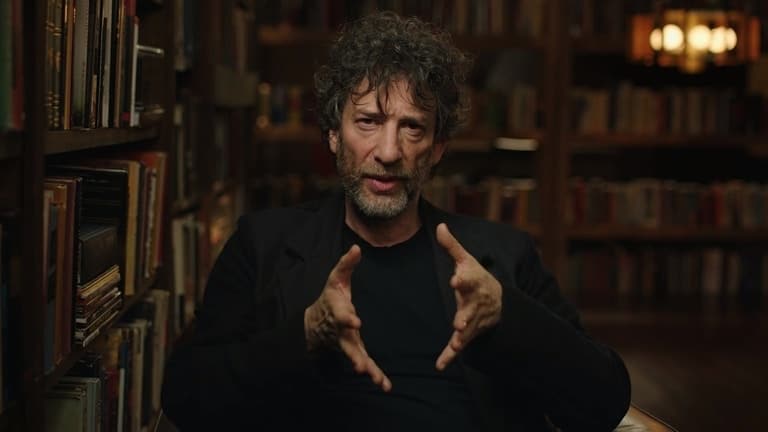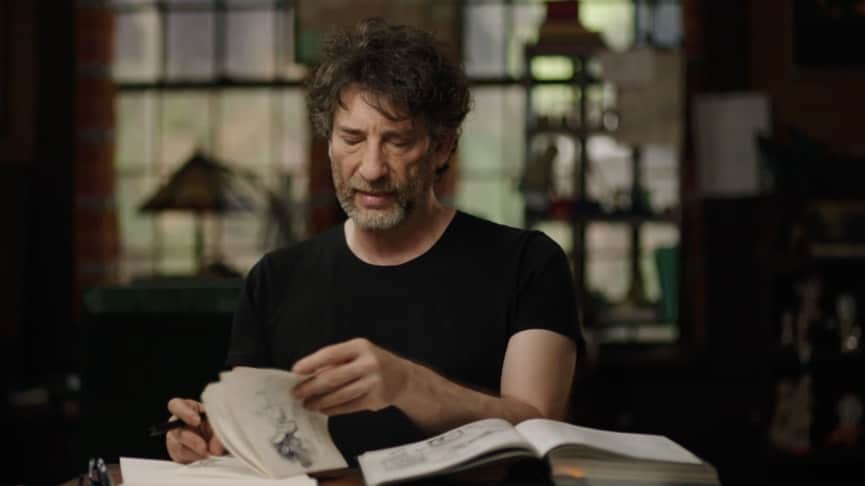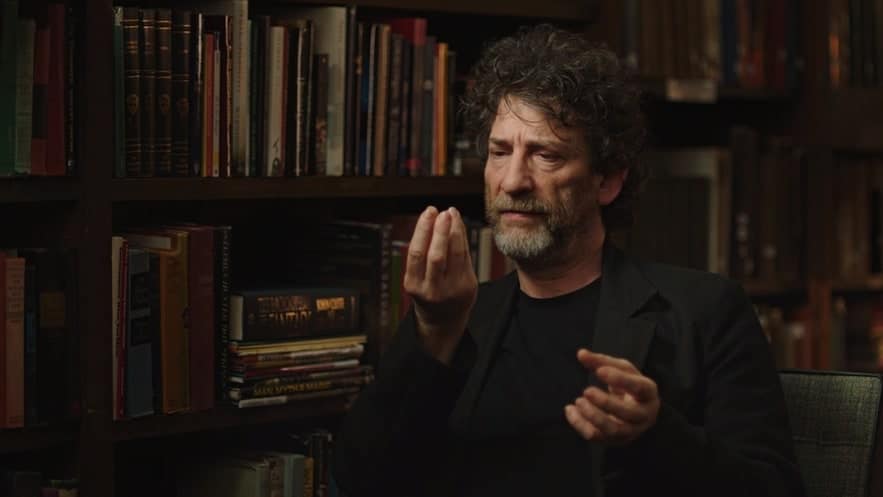Our review scores for the Neil Gaiman MasterClass:
Lessons – 7/10
Workbook – 7/10
The Community – 8/10
Value – 7.5/10
Overall Verdict – Thumbs Up!
What is MasterClass?
MasterClass provide online classes from a variety of well-known talents, covering a diverse range of topics that give advice, provide lessons to improve, or simply inspire.
The lessons are carried out in multiple short videos all of which are easy to access and resume at any time. You can watch them all in one go or pick them up here and there.
They are engaging and easy to understand, with the website keeping track of your progress to ensure accessibility. As well as providing videos, there are also workbooks that encourage participation and further the lessons taught.
Who is Neil Gaiman?
Neil Gaiman is a prolific writer of many different forms of writing – from novels, short stories, comic books, screenplays and graphic novels.
His body of work is so large it’s almost hard to know where to begin. He is probably best known though for his comic book series The Sandman, his novels Coraline, Stardust and American Gods and the TV series adaptations of his novels American Gods and Good Omens, for which he also penned the screenplays.
Gaiman is a writer who is incredibly versatile, moving from different forms of storytelling successfully and seamlessly. He’s therefore someone whose writing advice is of great value and insight into the craft of writing in general.
Neil Gaiman MasterClass PROS:
- Atmosphere – The overall feel of the lessons is identifiable to a fan of Gaiman’s work. The cuts between points throughout the lessons as well as the setting of the MasterClass are moody. They create a feel that Neil and his writing are well known for.
- Community – The community that comes along with the lessons is super interactive and there is a mass of posts from others that are easily accessible. This means it is super easy to discuss your thoughts with others who have experienced the MasterClass
- Personal experiences – Neil does often make references to his own past experiences from working as a lecturer to starting out in the industry. These added anecdotes help to show an audience that they too can achieve their goals. There’s an approachability here that is appealing.
Neil Gaiman MasterClass CONS:
- Similarity – Each of the lessons are carried out with the same structure of Neil talking straight to camera for the entirety of the video. This format can get tiring and repetitive especially after the significant number of lessons that there are.
- Formality – The overall feel of the MasterClass is very professional and put together. Whilst, this is appreciated, it could be intimidating for the audience. At times it’s hard to relate to Neil as he doesn’t show much of his personality or lifestyle outside of his writing.
- Flat Advice – At times, Neil’s advice or tips can feel generic and not thought out. He touches on an overarching theme but at times lacks further clarity or specific ways in which you can reach said steps.
Neil Gaiman MasterClass – The Lessons:
Neil’s lessons are broken down into 19 separate videos ranging from 8 to 27 minutes. Speaking directly to the camera, Gaiman creates an instant connection through his genuine passion for the craft. He easily puts the audience at ease as he compares his lessons through MasterClass to those he has taught as a Professor of the Arts at Bard College. It is clearly apparent that Gaiman is glad to share his own experience with those who are willing to listen.
In his introductory video, the first lesson, Gaiman highlights how he’ll give the audience his tips and tricks, in an incredibly efficient way.
He goes on to state his intentions for the MasterClass, likening it to ‘finding the writer’s tool-shed’ where he will show you certain tools as well as the pitfalls and the dos and don’ts. By the end, you’ll come out of the workshops with a much better idea than when you started.
Lesson Two – Truth in Fiction
Gaiman begins with a broad discussion about the importance of stories and how integral honesty is within fiction.
“You’re using the truth as a condiment to make an otherwise unconvincing narrative absolutely credible.“
Throughout this lesson, Gaiman stresses the importance of reading your own work as a craftsperson rather than a member of the audience. He repeatedly returns to the importance of:
- Not being scared to be judged by your work.
- Being honest because that is what people will ultimately respond to.
This first lesson stresses the need of bringing yourself into your writing whilst giving an overview of Gaiman’s view of fiction storytelling as a whole. It’s a compelling introduction.
Lesson Three – Sources of Inspiration
In his next lesson, Gaiman starts by saying that all writers should have a ‘compost heap’. He describes a metaphor of once what appears as seemingly rubbish developing into beautiful flowers. He states that everything that you as a writer hear, read or even the people you meet can be ‘thrown on the heap and in time grow into beautiful stories.
For the remainder of this lesson, Gaiman discusses the unlikely places in which a writer can find inspiration. He talks about:
- Not always realising the things that influence you as they may not immediately be comparable to your own work.
- He advises you to open yourself up to everything and subvert the familiar.
Both of which are pretty broad statements that Gaiman seemingly expects the audience to interpret in their own ways. This goes for the majority of the points throughout this lesson. Whilst Gaiman attempts to give instructions about taking a well-known fairy-tale and exploring it from a different angle, he stays general in his advice rather than offering definitive options on where to look.
Lesson Four – Finding Your Voice
In the third lesson, Gaiman talks through the basics of finding your individual voice as a writer. The overarching theme of the lesson is that finding your voice and style when you’re first starting out in the craft is huge. Gaiman states that a common problem that a lot of young writers have is, they don’t sound like anybody yet.
Gaiman advises:
- You must start with imitation. He explains that once you echo others’ style of writing then eventually you will come to know your own.
He goes on to give quite generic advice, such as:
- Get the bad words out, finish things and think about what the most important parts of your story are.
He continues to come back to the idea that the most important thing to do in order to find your own voice is to just write. Gaiman states:
“You learn more from finishing a failure than you do from writing a success.”
Gaiman spends the majority of this lesson telling anecdotes of his own writing experiences. He makes references to his own work such as American Gods and Ocean at the End of the Lane.
He also mentions his unsuccessful work, explaining in an encouraging manner that he has 100 to 200 ‘first pages’ of short stories that never went anywhere.
The biggest takeaway from this particular lesson is that there is no one way to find your voice. Each person’s experience is entirely unique. Therefore there is no one piece of killer advice that Gaiman can give, you have to find it yourself. This is a helpful insight if again a slightly familiar one.
Lesson Five – Developing Your Story
Throughout the fourth lesson, Gaiman touches on subjects surrounding the development of a story. He poses many questions for the audience in hopes of making them think deeper about the characters they are creating. He also gives small snippets of his own experience as his own answers.
Gaiman references young writers for the most part in his discussion, stating that a lot of the time, young writers cannot tell if they have a story to begin with. Later he also states that young or inexperienced writers also tend to shy away from conflict.
Throughout, he asks:
- Why should we care? Referencing both the writer and the reader.
- What is your story about?
- What do your characters want?
Gaiman reminds the audience that the power of stories lies in the question of ‘And then what happened?’, explaining that this question is the reason that a reader or audience will continue on with the story.
He ends the lesson by reminding the audience that most importantly, your characters should get what they need rather than what they want. This is a valuable section as it highlights something Gaiman is good at, making stories distinctive. He encourages the writer to truly interrogate why their story is meaningful. And this is a helpful insight into how and why you can make your own stories stand out.
Lesson Six: Story Case Study: The Graveyard Book
In this lesson, Neil makes reference to his young adult novel The Graveyard Book to discuss how character motivations are the essential building block of a compelling plot. This lesson is much shorter than those before it and therefore easy to watch and follow.
Gaiman reads aloud excerpts from his novel and as he reads, the segments of text are shown upon screen. Again this demonstrates the accessibility of this lesson.
He uses this lesson to show, for example, how easy it is to develop the character’s motivation throughout a story; breaking it down and chatting as he reads.
This lesson is fresh in comparison to those before it, as it gives a visual aid rather than watching Gaiman talk at the camera for the entirety of the lesson. It’s a helpful bit of show and tell teaching and rewarding to watch.
Lesson Seven: Short Fiction
Throughout this lesson, Gaiman discusses the short story and how to focus your scenes and descriptions in order to create maximum impact. Gaiman tells that writing short fiction is not simple. He continually returns to the idea of short journeys and how even those who specialise in short fiction continue to learn about their craft throughout their career, book after book.
Gaiman states that:
“When you’re writing short fiction, you don’t want to think that the characters have just come into existence for this one story”
This lesson is one of the most interesting of the Neil Gaiman MasterClass as it highlights a form not often taught or spoken about, short story writing. Gaiman’s insight here, therefore, feels quite unique and lies in contrast to more generic pieces of advice throughout.
Lesson Eight: Short Fiction Case Study: March Tale
Gaiman’s next lesson is a case study looking over his novel March Tale. This lesson’s main focus is to teach how to develop the narrative of your story by creating conflict between your characters. Similarly to his previous case study, he takes excerpts from his novel and analyses how the conflict through selected scenes helps deepen the tension and narrative.
Gaiman leads up to a short discussion about building your story to a satisfying climax. However, admittedly he spends the majority of his time reading from his novel instead of giving solid advice on how to replicate his own actions.
This lesson as well as the other case studies could be more valuable for fan’s of Gaiman’s novels as he goes into depth analysing his work instead of helping the audience with their own writing.
Lesson Nine: Dialogue and Character
Throughout this lesson, Gaiman’s aim is to teach about creating realistic dialogue and how to learn to trust your characters to ensure they are memorable.
He begins by stating that many say dialogue and character are two different things, when in fact they are the two integral aspects that ‘help a character walk’. Therefore, their importance is unlike anything else within your story.
Gaiman advises, for example:
- Listen to your characters
- Trust your characters
And as he states;
- Find the part of you that is your character, that way you can create realistic dimensions for your narrative.
The insight on character in this lesson feels instructive and valuable. Whilst listening to and trusting your characters seems like relatively obvious advice, the advice to connect yourself to the character is insightful and something tangible to put into practice.
Lesson Ten: Character Case Study: October Tale
This lesson focuses on character. Gaiman outlines how putting characters into unfamiliar territory can create tension. And there is yet another case study of Gaiman’s work.
Gaiman reiterates throughout that you will always get the best out of your characters once you put them into unfamiliar situations.
Gaiman states that:
- You should start with a bang. He references his own work with this statement, using this as a transition to read his short story aloud.
- Dialogue is what makes a character – it can also change the way a character is perceived.
This is another strong lesson and the show and tell aspect of it is what makes it so. Gaiman makes a point and then uses his own work to prove it. This is good teaching and moments like this are when the MasterClass feels at its most valuable.
Lesson Eleven: World-Building
The purpose of this lesson is to discuss the process of world-building – in particular, the do’s and don’ts that many young writers might face starting out in their career.
This lesson by far is Gaiman’s best. Again, Gaiman gives fragments of advice whilst relating it to his work, which an audience can easily take away. He handily breaks down the art of world-building and how easy it truly can be.
Gaiman also explains that something a lot of young or new writers tend to do is an act of ‘fan fiction’ in which they create stories in already established worlds. Instead, he gives some valuable advice to create your own world by looking at the real world.
He also makes a point of saying:
“The idea is so much better than I am a writer.”
This grounds him in reality and proves that even if we create an idea – we may not be ready to write it.
Lesson Twelve: Descriptions
Here Gaiman touches on how to develop your descriptive prose, including techniques and emotions to make your writing the best that it possibly can be. Gaiman admits that you can tell the audience as much and as little as you like depending on the story.
He explains, interestingly, that he doesn’t always believe in ‘show, don’t tell’ as you can use this technique to your advantage. Meaning, that whilst you describe what you have to describe, always include the most important description within your prose to evoke the most emotion.
Gaiman admits:
- The description of the settings and locations are just as important as the description of the characters.
- Use the appeal of the senses in your description, don’t forget to add details like: what does it smell or feel like? This sets the description apart from the rest.
This is quite unique advice and certainly feels worth noting down. Gaiman is giving direct, practical advice here – something that is easy to affect in your own screenplay immediately.
Lesson Thirteen: Humour
In this lesson, Gaiman talks through how he has used humour in his own work with specific references to techniques that he recommends. He begins by saying that humour is recognition, saying that jokes are simply recognising the funny parts of a scene and putting emphasis on them.
Gaiman also breaks down techniques including, for example:
- Sherbet lemons – these are little jokes throughout the prose.
- Figgings – which are jokes that appear to be ‘sherbet lemons’ at first but have a payoff in the end.
- Cigarettes – which are the roundups of your characters where every loose end is tied up.
This lesson stands out as one of the highlights of the whole class as it gives specific explanations and techniques for future use for the audience. Gaiman demonstrates a fresh approach to humour here and this is rewarding to learn about.
Lesson Fourteen: Genre
Gaiman’s lesson on genre breaks down the reader’s interlinked expectations of your story based on its genre and the ways in which you can shock or surprise the reader throughout your narrative. Gaiman states that as you are writing, you have to have an understanding of the reader’s expectations and the initial assumptions they will make based off of the story’s genre.
He advises, for example:
- Learn the rules in order to break them. What are the rules of the genre you’re working within and how can you break out of them?
- What will the audience feel cheated by if they don’t get from your story?
Gaiman guides that as you are starting out, you should stay away from genre fiction and the worlds that you know, because:
“If you write the fiction you know, the best you’ll be is a copy.”
Again, this is another lesson in the Neil Gaiman MasterClass that gives practical advice on how to stand out from the crowd. Making your writing distinctive is one of the most important elements of writing in general and so the direct ways Gaiman gives to do this are highly useful.
Lesson Fifteen: Comics
Whilst it is refreshing to see, this lesson may not be for everyone. The medium of graphic novels may not be as popular as prose that we have been learning about through each of the lessons beforehand. And so the addition of the lesson seems out of place in comparison to the others.
Lesson Sixteen: Dealing with Writer’s Block
Throughout this lesson, Gaiman encourages the audience to break through their writer’s block. This lesson shows Neil giving solid advice to many writers’ problems. He motivates the audience by giving options such as:
- Retrace your steps. You have to look back at where you went wrong in order to move forward.
- Be willing to recalibrate and re-plot your story in order to get its full potential.
- Remember that writer’s block isn’t a real thing.
Gaiman highlights this last point, explaining that if you are feeling stuck then get up and do something else rather than letting it taint the work you’ve already achieved.
“Where you went off the rails, will become obvious.”
This lesson helps to encourage the writer to continue on their writing journey and is one of the most effective in terms of value. This is where Gaiman’s experience is very evident and this transfers to the viewer satisfyingly. All the advice might not be the most original but it’s useful nonetheless.
Lesson Seventeen: Editing
As Gaiman begins to wrap up his instructions, he moves on to the discussion of redrafting and editing his work. Gaiman normalises the process and attempts to make it less scary. He breaks down each part of the process, showing that it doesn’t have to be daunting and explains that writing is all about creating and fixing.
Gaiman admits that you cannot obsess over perfection because it simply isn’t achievable and if you don’t write what you want to write then you could miss your chance.
Lesson Eighteen: Rules for Writers
Throughout the penultimate lesson of the Neil Gaiman MasterClass, Gaiman gets honest about the rules of writing and how to normalise the act of writing so that you can too become successful. Gaiman keeps up his motivating tone throughout as he states all of the things which many writers face and explains simply that they are normal.
Gaiman is at his best when he is encouraging and giving real advice which the audience can take away. This lesson sees him normalise his career and show that anything is achievable if you put the work it.
Lesson Nineteen: The Writer’s Responsibilities
Gaiman begins his final lesson by telling a story that helped him come to terms with his responsibilities as a writer. He explains that there are many things a writer is responsible for such as:
- Having a point of view.
- Doing your character’s justice.
- Believing in your writing.
Gaiman’s parting advice is positive and yet bittersweet as it feels as if the true value of the lesson was just getting started.
His finishing statement says:
“Do a lot of living, because everything that happens in the living is going to end up in the fiction.”
Whilst this is interesting and illuminating advice, it’s a little woolly. And it pales in comparison to the previous lessons that give practical advice. It’s clearly advice that rings true but it’s not exactly what writers might have tuned in to hear.
The Neil Gaiman MasterClass Lesson Ratings:
- Truth in Fiction – 8/10
- Sources of Inspiration – 6/10
- Finding Your Voice – 7/10
- Developing Your Story – 7/10
- Story Case Study: ‘The Graveyard Book’ – 7/10
- Short Fiction – 8/10
- Short Fiction Case Study: ‘March Tale’ – 7/10
- Dialogue and Character – 7/10
- Character Case Study: ‘October Tale’ – 7/10
- World Building – 8/10
- Descriptions – 9/10
- Humour – 8/10
- Genre – 7/10
- Comics – 6/10
- Dealing with Writer’s Block – 8/10
- Editing – 7/10
- Rules for Writer’s – 8/10
- The Writer’s Responsibilities – 7/10
Neil Gaiman MasterClass – The Workbook
The workbook for Neil Gaiman’s MasterClass definitely enhances the quality and value of the video lessons. Whilst it does repeat the majority of what Gaiman covers in the lessons, it has added extras throughout such as writing exercises and worksheets. These strengthen the MasterClass as a whole. Each of the lessons has its own section in the workbook, allowing the audience to read through in time with the videos.
The workbook begins with an extensive introduction to Neil and includes a recommended reading list of Neil’s work, allowing the reader to identify themselves with Neil and his previous work before beginning the course.
The coursework is split into two sections – the ‘Writing Exercises’ which allows the reader to practice the tools that Neil discusses throughout the lessons and ‘For Your Novel’ sections which apply the techniques to writing a novel. This added aspect is helpful as it puts the techniques discussed into practice and shows how they work methodically.
It is an extensive read and at times can be repetitive and slow. However, overall the workbook is definitely beneficial. It enhances the overall experience of the course as it gives written assignments as an extension to the lessons.
Neil Gaiman MasterClass – The Community
The community for the Neil Gaiman MasterClass is one that massively excels. The community is well used and organised, with each lesson heavily followed up with responses from members of the community. This would no doubt further boost the enjoyment of the MasterClass as you are able to work alongside others who are interested in the same subjects.
There are a variety of topics within ‘The Hub’. These are heavily led by community members as they ask for further advice and answer queries from their peers. Proving that this interactive segment of the MasterClass is worth it. The one thing that would further this area is if Neil himself was able to interact with the audience more. This would develop the relationship between talent and audience better.
Neil Gaiman MasterClass – The Value
MasterClass charges $180 annually. Whilst this is a large cost – this gives the viewer access to a large variety of courses that are uploaded monthly. The question of whether or not it is worth the money will differ depending on the specific person and their needs.
However, the lessons and courses overall are definitely useful if you find the subjects that you are particularly passionate about. The Neil Gaiman MasterClass is useful for those looking to get into writing or those who are looking to enhance their established craft. The Neil Gaiman MasterClass is ultimately worth the money as:
- There is a large number of classes in comparison to others on the website. And these cover a variety of subjects.
- Neil Gaiman gives important tips which are further strengthened within the workbook. This points the viewer in the correct direction and provides a hopeful future for a writing career.
- Gaiman gives advice and teaches skills that otherwise would be costly and are delivered in an easy to access way.
Neil Gaiman MasterClass – An Overview
Gaiman’s discussions are interesting to listen to and informing to an extent. The first half of the lessons do at times drag. Moreover, they often contain a lot of basic advice that could be described as surface level.
Considering the amount of lessons, the topics could have been explored even deeper and focused more on the potential for the viewer rather than Gaiman reading through large excerpts of his own writing. Whilst seeing his work is at times helpful – it can weigh the lesson down rather than strengthening the overall message.
As Gaiman states ‘A writer’s voice is what the reader responds to at the end of the day’. And this MasterClass gives a beginning insight on how to establish yourself within your writing and take the first steps in your career.
The Neil Gaiman MasterClass is a great place to begin when starting from scratch as a writer and looking to research on your first steps. However, it lacks clarity in areas that a more experienced writer may benefit from.
– What did you think of this article? Share It, Like It, give it a rating, and let us know your thoughts in the comments box further down…
– Struggling with a script or book? Story analysis is what we do, all day, every day… check out our range of script coverage services for writers & filmmakers.
This article was written by Camerin Macfarlane and edited by IS Staff.
Get *ALL* our FREE Resources
Tackle the trickiest areas of screenwriting with our exclusive eBooks. Get all our FREE resources when you join 60,000 filmmakers on our mailing list!







